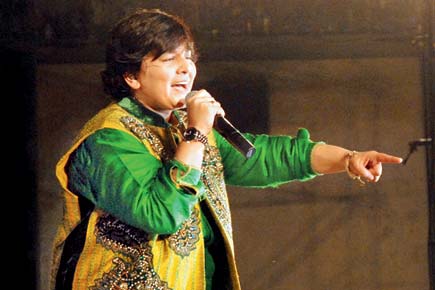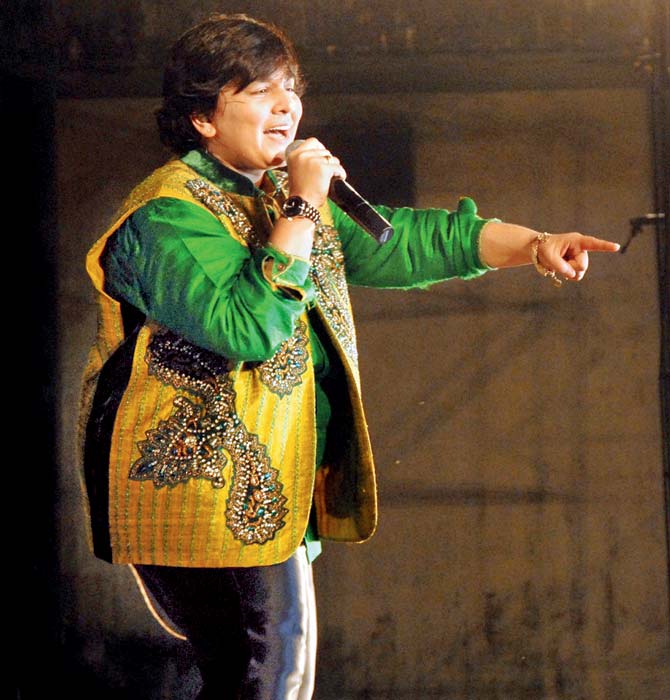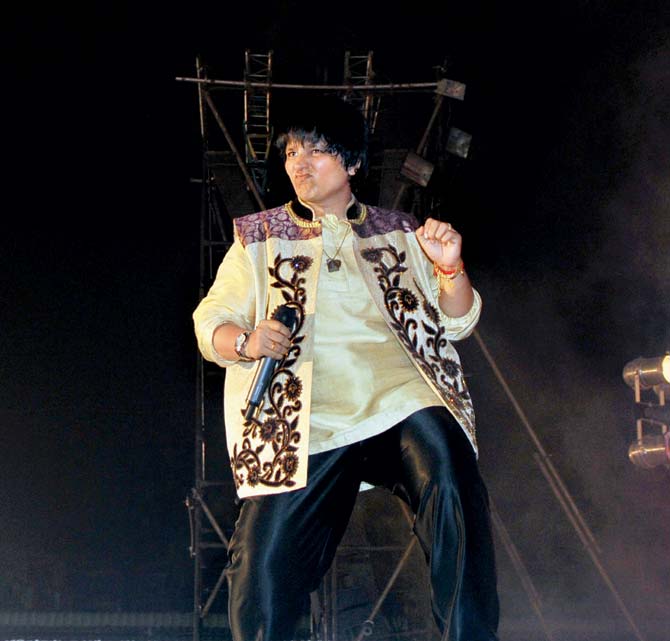As the Navratri season nears, dandiya queen Falguni Pathak tells us how she still manages to keep her shows full paisa vasool and the kind of money she earns


"You're 52, how long do you intend to crank up dandiya beats,” we ask the terribly shy, quiet Falguni Pathak. For once, she misses a beat herself. Her eyes survey her team — seated around us in a circular table at the Ambassador Hotel in Churchgate — strangely glued to our conversation, even clicking pictures of this interview. "I'm not 52. I’m 45," Falguni says. Oh, damn Wikipedia. "Aaj kal log Wikipedia pe kuch bhi dalte hain," her crew joins in. I agree.
ADVERTISEMENT

To be fair, the slightly stout, short Falguni, in a black formal jacket, smart trousers, and a pendant around her neck, has looked the same for so long that it’s really hard to tell how old she could be — fit to be modelled as a timeless bobbing doll, with cropped hair (called 'boy-cut' back in the day), gentle smile — looking anywhere between 25 and 52.
This face dominates Mumbai’s imagination for a week-plus, once every year. Which makes Falguni far more of a seasonal worker than a single-crop farmer — she comes in during Navratri, blasts music with her back-up band Tathaiya, mints moolah over nine to 11 days (it’s 11 this year), and then, it seems, she disappears altogether. You hear nothing about her (album, soundtrack, concerts). Even her public appearances are limited, if not zero.
Starting October 1, it’d be that time of the year again that generates two customary pieces of news: young girls missing their periods (abortion rates shooting up); and thousands dressed in flashy ethnic clothes, holding sticks, matching steps, with Falguni leading the city’s biggest party that moves venue every other year. Pushpanjali Gardens in the predominantly Gujarati neighbourhood Borivili is Falguni’s haunt for 2016.
And she’s been packing garba grounds (anywhere between 15,000 to 25,000 people per night) since 1994, when she first sang at a Navratri gig in Khar, where she grew up. Her father didn’t approve of her career choice initially. “He’s no more, but he would be proud (of me),” Falguni says.
He would be. What makes Falguni practically number one, in the field of one? What’s so different about Navratri/garba music that sets her apart? Well, it is different all right. For a precious clue, consider that over the years, one of the most popular dandiya songs has been Paree hoon main, a kinda hip, indie-pop number by Suneeta Rao, who may well be remembered forever, thanks to Navratris alone.
Faguni discovered that unlikely song for dandiya: "Even before I’d started performing professionally for Navratri, someone from the audience had once come up back-stage with a cassette, asking me to try out the Side-B last song. At every performance since, I’ve played Paree hoon main. The groove is perfect for (dandiya) beats." Kai Po Che (2013), the well-researched film set in Gujarat, if you recall, had rightly placed the Suneeta Rao song in its garba scene. Another number from Kai Po Che soundtrack, Shubharambh, Falguni says, is ideal for dandiya as well.
The formula, as Falguni explains it, is quite simple: “The garba ‘theka’ (beat) has to be the same. It’s derived from the ‘dakla’ (damru) beats that play at temples in Gujarat. While the beats can’t change, the songs must. But whatever the song, (dance) step tootna nahin chahiye (tempo mustn’t break)."
Falguni’s challenge therefore is to sample all types of desi music to pick tracks that can be seamlessly aligned to the dandiya rhythm. She says, "Earlier I would attend garbas in villages in Gujarat, and source local CDs from there... Internet has made that process easier.” And given that her audience is also fairly cosmopolitan, "some of them travelling from different parts of India and the world to play garba,” she makes sure to include Punjabi, Marathi, even South Indian tracks. This is besides devotional songs she concentrates on. "Navratri, after all, is a religious festival,” she says. Even if entertainment is the point of it all.
Bollywood, one hears, dominates the charts. Speaking of which, Falguni says the Bollywood track that was a major dandiya success last year was Gulaabo from Shandaar. And this year? "I’m still preparing the list. But an instrumental version of two songs from Sultan — 440 volt, which is in 6-8 beat, and Jag ghoomeya in 2-4 beat — should work."
Despite getting the pulse of her audience pat-on, Falguni’s business, as with Navratri in general, took a hit in 2000, when the state imposed the 10 pm deadline for use of loud speakers in public. The rule was modified in 2002 to allow for Navratri shows to carry on until midnight over weekends. Until these diktats, Navratri shows in Mumbai would continue all through the night — finishing around six in the morning. "I just have to compress the whole show into three-and-half hours now, ensuring that it’s still 'paisa vasool'," Falguni says.
Has that affected her income as well? The only confirmed figure for what she charges that I came across was Rs 1.6 crore for the 10-day gig. True? "Kaash (I wish),” Falguni smiles, elaborating that she could command that cheque if she performed outside Mumbai. As she did in Ankleshwar in Gujarat, during Navratri in 2010. "But what I charge includes (payments for) my 40 musicians, costumes, rehearsals, sound and light."
This is when one of her crewmembers butts in, "Too many IT raids happening, let’s not talk about money." At some point, another one exults, "Ho gaya!" He’s managed to change Falguni’s age on the wiki. Good.
 Subscribe today by clicking the link and stay updated with the latest news!" Click here!
Subscribe today by clicking the link and stay updated with the latest news!" Click here!







